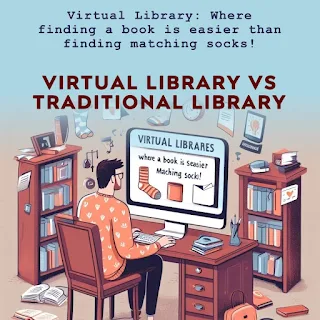In the ever-evolving world of information and education, the way we access knowledge has transformed significantly. Traditional libraries have long been the cornerstone of learning and research, but with the advent of technology, virtual libraries have emerged as a formidable alternative. This blog post delves into a comparative exploration of these two approaches to accessing information, shedding light on their respective advantages, limitations, and the future of library services.
Traditional Library:
The traditional library, often characterized by rows of physical books and a serene reading environment, has been an essential part of educational and research institutions for centuries. It offers a tangible space where individuals can immerse themselves in the world of knowledge. Some key aspects of traditional libraries include:
- Tangibility: Traditional libraries offer a sensory experience - the scent of books, the feel of turning pages, and the comforting silence. For many, this tactile experience remains irreplaceable.
- Community Hub: Libraries are often community hubs, hosting events, book clubs, and lectures, fostering a sense of togetherness and intellectual exchange.
- Expert Assistance: Librarians play a crucial role in guiding visitors to the right resources, helping with research, and ensuring access to accurate information.
Virtual Library:
Virtual libraries, on the other hand, have revolutionized the way we access information. They are digital platforms where vast collections of e-books, academic journals, and multimedia resources are available. Here are some key aspects of virtual libraries:
- Accessibility: Virtual libraries can be accessed from anywhere with an internet connection. This unparalleled accessibility empowers learners and researchers worldwide.
- Convenience: With the ability to search, bookmark, and annotate digital resources, virtual libraries offer a level of convenience that traditional libraries can't match.
- Cost-Effective: Virtual libraries often reduce costs associated with maintaining physical collections and infrastructure, making them a more budget-friendly option for institutions.
Comparative Analysis:
To better understand the strengths and limitations of each, it's essential to compare virtual libraries and traditional libraries side by side.
Advantages of Virtual Libraries:
- Accessibility and Convenience: Virtual libraries offer the unparalleled advantage of anytime, anywhere access. This is a game-changer for students, researchers, and anyone seeking information in our fast-paced digital age.
- Search and Navigation: Digital libraries feature advanced search tools, making it easy to find specific resources quickly. Navigation is intuitive, allowing users to filter results based on various criteria.
- Multimedia Content: Virtual libraries can host a vast array of multimedia content, including videos, audio recordings, and interactive simulations, enhancing the learning experience.
- Cost Efficiency: Virtual libraries often require fewer physical resources, reducing operational costs and making them a more cost-effective option for institutions.
Limitations of Virtual Libraries:
- Digital Divide: Not everyone has equal access to the internet, which creates a digital divide. Some may be excluded from the benefits of virtual libraries due to economic or geographic reasons.
- Lack of Tangibility: The absence of physical books and the sensory experience of a traditional library can be seen as a drawback for those who cherish these aspects.
Advantages of Traditional Libraries:
- Tangibility and Ambiance: Traditional libraries provide a unique ambiance that fosters deep concentration and contemplation. The tactile experience of holding a book is irreplaceable for many.
- Human Interaction: Traditional libraries serve as hubs for face-to-face interaction, enabling readers to engage with librarians and fellow scholars, fostering a sense of community.
- Archival Preservation: Traditional libraries safeguard historical and rare manuscripts, ensuring their preservation for future generations.
Limitations of Traditional Libraries:
- Limited Accessibility: Traditional libraries have geographical restrictions and their operating hours can be inconvenient for some users.
- Limited Resources: Physical space limitations can result in restricted collections, and libraries may not always have the latest materials due to budget constraints.
In the ongoing debate between virtual libraries and traditional libraries, there's no clear winner. Both have distinct advantages and limitations, and their relevance depends on individual needs, access, and preferences. While virtual libraries offer unparalleled accessibility and convenience, traditional libraries provide an irreplaceable sense of tangibility and community. The future may hold a harmonious balance between the two, with libraries evolving to integrate the best of both worlds. Ultimately, the choice between these libraries boils down to the purpose, the value of human interaction, and the individual's technological access and comfort. Embracing the strengths of each library type and adapting to the evolving information landscape will ensure a more enriched learning and research experience for all.























